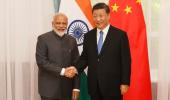We need to develop and deploy asymmetric capabilities in the short term to deter an assertive China even while focussing on mastering, over time, emerging technological capabilities which are now the basis for geopolitical influence, says Shyam Saran.

The United States and China are locked in a sharpening strategic confrontation that is likely to dominate international relations for the foreseeable future.
There may well be phases of remission just as there had been in the Cold War of the previous century between the US and Soviet Union but these will be tactical and temporary.
The rivalry will not be played out in military and ideological terms only as in the previous Cold War. The new Cold War will be centred on mastery of technology as the currency of power.
The US is currently engaged in constructing a range of technology denial measures against China and is mobilising its allies and friends to do the same.
This is not easy since China is embedded in a densely inter-connected global economy and is part of several critical supply chains which cannot be unravelled in a hurry.
Over the past two decades, China has been engaged in a large scale and systematic effort to acquire, adopt and assimilate advanced technologies from Western countries, in particular the US.
Since embarking on its reform and liberalisation policy in 1978, it has been able to send several hundred thousand Chinese to study in top Western institutions, bringing back to the country a formidable pool of knowledge.
This has served as the foundation for China's transformation from a technology seeker to a technology generator. This has not only enabled China to sustain a high rate of economic growth over the past four decades but has enabled it to build a modern and technologically sophisticated military machine.
While US actions may slow down China's accumulation of power, a reversal is unlikely unless domestic political disruption intervenes. This appears unlikely given the fact that technological capabilities now extend to mass surveillance and virtually instant response to domestic security threats.
China's response to denial of technology has been 'doubling down on indigenous innovation' and developing 'core technologies' which are precisely the domains identified in the China 2025 plan and include IT, machine learning, quantum computing and artificial intelligence (AI).
At present, China lags behind in semi-conductors and imported $300 billion worth in 2018. Now huge investments have been announced in this sector, estimated at $ 100-150 billion in public and private funds over the next few years.
Major Chinese firms like Baidu, Alibaba and Huawei have been working to design and produce their own microchips.
Alibaba launched its own semi-conductor division, Pingtouge, in September last year to develop AI chips for cloud computing and internet connected devices.
Huawei will spend $300 million each year over the next five years to design and produce new generation chips. It unveiled a 7nm microchip in August last year. China is ahead of the US in quantum computing and as of 2017 had filed twice as many patents as US companies.
Taking advantage of having a massive pool of citizens' data, with no concerns over privacy, China has accorded the highest priority to developing its capabilities in AI.
Its Next Generation Artificial Intelligence Development Plan seeks to make the country the world leader in AI and associated technologies by 2030.
Chinese overall spending on R&D was $376 billion in 2015, as compared to $13 billion in 1991 and exceeded the R&D expenditure of Japan, Germany and South Korea combined.
Technology is also at the centre of China's military strategy.
One key feature is that over the past two decades, China has pursued 'civil-military fusion', consciously applying technologies from the civilian sector, including those acquired from abroad for commercial purposes, to military applications.
It has also utilised its cyber capabilities to gain access, through hacking, to cutting edge military technologies developed through years of research by US firms.
US citizens of Chinese origin and Chinese scholars working in sensitive facilities have often been mobilised to clandestinely transfer confidential plans and blueprints to Chinese entities.
However, this should not detract from the advances China is making in generating advanced technologies in its own research and technical institutions based on the vast knowledge pool that it has acquired over the years from multiple engagements with the US, Japan and Europe.
As its technological capabilities have progressed, its military strategy has also undergone changes.
In the first phase, China drew lessons from Operation Desert Storm in 1991, in which the US forces used Precision Guided Missiles (PGM) and integrated information networks to overwhelm the formidable conventional forces deployed by Iraq.
This led to the concept of 'informationised warfare' which impressed Chinese military planners who then determined to master it over time.
The restructuring of the PLA to achieve 'jointedness' among the land, sea and air forces and the integration of space, cyber and electronic warfare capabilities have enabled seamless system platforms.
In 1996, the Chinese felt humiliated by their powerlessness against the two US carrier groups that steamed into the Taiwan Straits after China began lobbing missiles around Taiwan as a show of force.
China began developing asymmetric capabilities to make any similar US move in the future both risky and costly.
The DF-21 D anti-carrier ballistic missile with a 1,000 mile range was the result. That the US acquiesced in China's artificial island building in the South China Sea and its subsequent militarisation of these islands, may have convinced China that it now has those asymmetric capabilities in place.
More recently, Chinese military strategists have been talking about moving towards 'intelligentised warfare' using AI in weapons development and military tactics.
If the earlier contestation was between informationised systems, the future they claim would be marked by 'algorithmic competition' in which China believes it is racing ahead of the US.
The US is currently debating a credible and effective counter-strategy but there are even more ominous implications for India's security.
These need to be assessed carefully and comprehensively and an appropriate strategy crafted to deal with the challenge posed by these developments.
Like China in an earlier phase, we need to develop and deploy asymmetric capabilities in the short term to deter an assertive China even while focussing on mastering, over time, emerging technological capabilities which are now the basis for geopolitical influence.
Shyam Saran is a former foreign secretary and a Senior Fellow, CPR.











